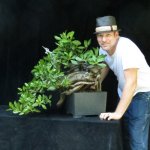
This Ligustrum was collected not from the wild, but from a landscape planting, which questions if it should be considered a "yamadori", or not... my own personal perspective is who cares... it is not a deciduous either seeing it does not drop it's leaves...
It is however over a hundred years old, has a massive hollowed trunk and deadwood, and is gigantic in size!
It had to be severely cut down to size just to fit into the 20 inch wide pot that I put it into! It eventually will go into a slightly larger pot for its a tad small, but all I had at the time and needed to begin the process if making it a bonsai.
Just started this one this year... will need a couple of years of getting branches where I need them and some ramification, which will decrease leaf size. Again, not the 40 years...
What I think is being missed with this discussion is that if one has a piece of ancient yamadori or old massive stock such as this and those conifers of the Cup... one does not have to often spend years upon years developing to bring the tree to a stage of being shown.
Yes, with more time the tree is only going to improve and get better as the years go by... but, if one is trying to make a tree that is old, rugged and been abused... it is far faster and easier to pull off then if one is trying to make a perfect un flawed tree. Flaws are what are required of ancient rugged trees... not what are required of ancient looking maples let's say...
So, it is understandable how a collected conifer can be show ready in a very short time, and how perhaps a maple might take 10 times that... This is comparing Apples to Oranges! I think we need to understand this and understand that totally different amounts if time are going to be required of each.
I can style a juniper make it rugged, like it has been through hell and back, and in a year put it in a show. I cannot do this with a tree that needs to take time to heal over wounds... will not happen.
Has little to do with whether or not I am Japanese, or if they are better at the Art than we here in the states are... but more to do with one factor, time... They have been doing it longer, so yeah, makes perfect sense why trees from Japan might be further along.
If one wants to speed up the process, style a tree in not a perfect manner... instead of healing over those scars, turn them into features... spend your effort on branching.



